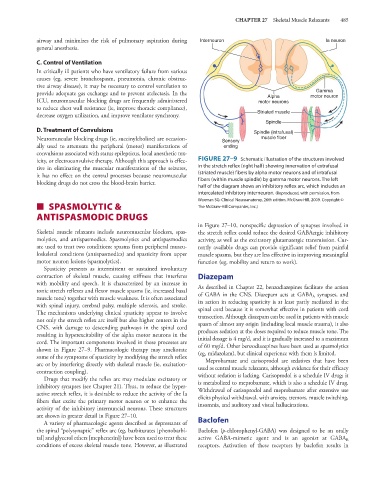Page 499 - Basic _ Clinical Pharmacology ( PDFDrive )
P. 499
CHAPTER 27 Skeletal Muscle Relaxants 485
airway and minimizes the risk of pulmonary aspiration during Interneuron Ia neuron
general anesthesia.
C. Control of Ventilation
In critically ill patients who have ventilatory failure from various
causes (eg, severe bronchospasm, pneumonia, chronic obstruc-
tive airway disease), it may be necessary to control ventilation to
Gamma
provide adequate gas exchange and to prevent atelectasis. In the motor neuron
Alpha
ICU, neuromuscular blocking drugs are frequently administered motor neurons
to reduce chest wall resistance (ie, improve thoracic compliance),
decrease oxygen utilization, and improve ventilator synchrony. Striated muscle
Spindle
D. Treatment of Convulsions Spindle (intrafusal)
Neuromuscular blocking drugs (ie, succinylcholine) are occasion- Sensory muscle fiber
ally used to attenuate the peripheral (motor) manifestations of ending
convulsions associated with status epilepticus, local anesthetic tox-
icity, or electroconvulsive therapy. Although this approach is effec- FIGURE 27–9 Schematic illustration of the structures involved
tive in eliminating the muscular manifestations of the seizures, in the stretch reflex (right half) showing innervation of extrafusal
it has no effect on the central processes because neuromuscular (striated muscle) fibers by alpha motor neurons and of intrafusal
blocking drugs do not cross the blood-brain barrier. fibers (within muscle spindle) by gamma motor neurons. The left
half of the diagram shows an inhibitory reflex arc, which includes an
intercalated inhibitory interneuron. (Reproduced, with permission, from
Waxman SG: Clinical Neuroanatomy, 26th edition. McGraw-Hill, 2009. Copyright ©
■ SPASMOLYTIC & The McGraw-Hill Companies, Inc.)
ANTISPASMODIC DRUGS
in Figure 27–10, nonspecific depression of synapses involved in
Skeletal muscle relaxants include neuromuscular blockers, spas- the stretch reflex could reduce the desired GABAergic inhibitory
molytics, and antispasmodics. Spasmolytics and antispasmodics activity, as well as the excitatory glutamatergic transmission. Cur-
are used to treat two conditions: spasms from peripheral muscu- rently available drugs can provide significant relief from painful
loskeletal conditions (antispasmodics) and spasticity from upper muscle spasms, but they are less effective in improving meaningful
motor neuron lesions (spasmolytics). function (eg, mobility and return to work).
Spasticity presents as intermittent or sustained involuntary
contraction of skeletal muscle, causing stiffness that interferes Diazepam
with mobility and speech. It is characterized by an increase in As described in Chapter 22, benzodiazepines facilitate the action
tonic stretch reflexes and flexor muscle spasms (ie, increased basal of GABA in the CNS. Diazepam acts at GABA synapses, and
A
muscle tone) together with muscle weakness. It is often associated its action in reducing spasticity is at least partly mediated in the
with spinal injury, cerebral palsy, multiple sclerosis, and stroke. spinal cord because it is somewhat effective in patients with cord
The mechanisms underlying clinical spasticity appear to involve transection. Although diazepam can be used in patients with muscle
not only the stretch reflex arc itself but also higher centers in the spasm of almost any origin (including local muscle trauma), it also
CNS, with damage to descending pathways in the spinal cord produces sedation at the doses required to reduce muscle tone. The
resulting in hyperexcitability of the alpha motor neurons in the initial dosage is 4 mg/d, and it is gradually increased to a maximum
cord. The important components involved in these processes are of 60 mg/d. Other benzodiazepines have been used as spasmolytics
shown in Figure 27–9. Pharmacologic therapy may ameliorate (eg, midazolam), but clinical experience with them is limited.
some of the symptoms of spasticity by modifying the stretch reflex Meprobamate and carisoprodol are sedatives that have been
arc or by interfering directly with skeletal muscle (ie, excitation- used as central muscle relaxants, although evidence for their efficacy
contraction coupling). without sedation is lacking. Carisoprodol is a schedule IV drug; it
Drugs that modify the reflex arc may modulate excitatory or
inhibitory synapses (see Chapter 21). Thus, to reduce the hyper- is metabolized to meprobamate, which is also a schedule IV drug.
Withdrawal of carisoprodol and meprobamate after extensive use
active stretch reflex, it is desirable to reduce the activity of the Ia elicits physical withdrawal, with anxiety, tremors, muscle twitching,
fibers that excite the primary motor neuron or to enhance the insomnia, and auditory and visual hallucinations.
activity of the inhibitory internuncial neurons. These structures
are shown in greater detail in Figure 27–10.
A variety of pharmacologic agents described as depressants of Baclofen
the spinal “polysynaptic” reflex arc (eg, barbiturates [phenobarbi- Baclofen (p-chlorophenyl-GABA) was designed to be an orally
tal] and glycerol ethers [mephenesin]) have been used to treat these active GABA-mimetic agent and is an agonist at GABA
B
conditions of excess skeletal muscle tone. However, as illustrated receptors. Activation of these receptors by baclofen results in

